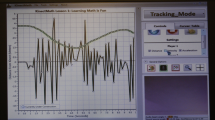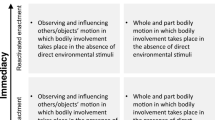Abstract
Biomechanics, and specifically the biomechanics associated with human movement, is a potentially rich backdrop against which educators can design innovative science teaching and learning activities. Moreover, the use of technologies associated with biomechanics research, such as high-speed cameras that can produce high-quality slow-motion video, can be deployed in such a way to support students’ participation in practices of scientific modeling. As participants in classroom design experiment, fifteen fifth-grade students worked with high-speed cameras and stop-motion animation software (SAM Animation) over several days to produce dynamic models of motion and body movement. The designed series of learning activities involved iterative cycles of animation creation and critique and use of various depictive materials. Subsequent analysis of flipbooks of human jumping movements created by the students at the beginning and end of the unit revealed a significant improvement in both the epistemic fidelity of students’ representations. Excerpts from classroom observations highlight the role that the teacher plays in supporting students’ thoughtful reflection of and attention to slow-motion video. In total, this design and research intervention demonstrates that the combination of technologies, activities, and teacher support can lead to improvements in some of the foundations associated with students’ modeling.






Similar content being viewed by others
Notes
Of the fifteen students, one had some special needs and was allowed to opt out of any assessment-related work for this unit. He is not represented in the assessment results described in the latter parts of this article. However, this student’s contributions to class activities were recorded and stored on research video with appropriate consent.
The cafeteria had better lighting and more room for students to gather and observe what was being recorded.
The artist’s mannequin was initially seen by students as an easy and desirable object to use because it had the shape of a person. However, the students soon discovered that it had some major movement and position limitations and was difficult to use for the kinds of two-dimensional animations they were creating.
Initially, we had 17 components with one related to maintaining consistent proportions across the flipbook. The agreement on this component was low (33 % agreement), so this was eliminated.
One student needed to leave class prior to completion of a second flipbook depicting the horizontal jump, and thus had unmatched data and was excluded from this analysis.
All proper names are pseudonyms.
Indeed, the velocity of the ball decreases over time as the ball eventually comes to a stop. However, as Parnafes (2007) has noted, students’ recognition of what is “fast” can involve attention to a number of visible aspects of an analyzed situation.
References
Abrahamson D (2009) Embodied design: constructing means for constructing meaning. Educ Stud Math 70(1):27–47. doi:10.1007/s10649-008-9137-1
Achieve Inc (2013) Next generation science standards. Achieve, Inc., Washington, DC
Alexander RM (1992) The human machine. Columbia University Press, New York
Azevedo F (2000) Designing representations of terrain: a study in meta-representational competence. J Math Behav 19(4):443–480
Azevedo FS, diSessa AA, Sherin BL (2012) An evolving framework for describing student engagement in classroom activities. J Math Behav 31(2):270–289. doi:10.1016/j.jmathb.2011.12.003
Ballarotti MG, Saba MMF, Pinto O (2005) High-speed camera observations of negative ground flashes on a millisecond-scale. Geophys Res Lett 32(23):L23802. doi:10.1029/2005gl023889
Barbosa TM, Bragada JA, Reis VCM, Marinho DA, Carvalho C, Silva ANJ (2010) Energetics and biomechanics as determining factors of swimming performance: updating the state of the art. J Sci Med Sport 13(2):262–269. doi:10.1016/j.jsams.2009.01.003
Barr R, Pandy M, Petrosino A, Svihla V (2005) Challenge-based instruction: the VaNTH biomechanics learning modules. Paper presented at the Frontiers in Education, 2005. FIE ‘05. Proceedings 35th annual conference
Barsalou LW (1999) Perceptual symbol systems. Behav Brain Sci 22(04):577–660
Bell P, Lewenstein B, Shouse AW, Feder MA (2009) Learning science in informal environments: people, places, and pursuits. National Academies Press, Washington, DC
Boyd A, Rubin A (1996) Interactive video: a bridge between motion and math. Int J Comput Math Learn 1(1):57–93
Brown AL (1992) Design experiments: theoretical and methodological challenges in creating complex interventions in classroom settings. J Learn Sci 2(2):141–178
Danish JA, Enyedy N (2006) Negotiated representational mediators: how young children decide what to include in their science representations. Sci Educ 91(1):1–35
diSessa AA (2002) Students’ criteria for representational adequacy. In: Gravemeijer K, Lehrer R, Verschaffel L (eds) Symbolizing, modeling and tool use in mathematics education. Springer, New York, pp 105–130
diSessa AA (2004) Metarepresentation: native competence and targets for instruction. Cogn Instr 22(3):293–331
diSessa AA, Hammer D, Sherin B, Kolpakowski T (1991) Inventing graphing: meta-representational expertise in children. J Math Behav 10:117–160
Duschl RA, Schweingruber HA, Shouse AW (2007) Taking science to school: learning and teaching science in grades K-8. The National Academies Press, Washington, DC
Elby A (2000) What students’ learning of representations tells us about constructivism. J Math Behav 19:481–502
Enyedy N (2005) Inventing mapping: creating cultural forms to solve collective problems. Cogn Instr 23(4):427–466
Enyedy N, Danish J, Delacruz G, Kumar M (2012) Learning physics through play in an augmented reality environment. Int J Comput Support Collab Learn 7(3):347–378. doi:10.1007/s11412-012-9150-3
Gravel BE (2009) Science of SAM: why animation is good for the classroom. Unpublished white paper. Tufts University, Medford, MA
Hall R, Nemirovsky R (2011) Introduction to the special issue: modalities of body engagement in mathematical activity and learning. J Learn Sci 21(2):207–215. doi:10.1080/10508406.2011.611447
Karmiloff-Smith A (1990) Constraints on representational change: evidence from children’s drawings. Cognition 34:57–83
Klein SS, Sherwood RD (2005) Biomedical engineering and cognitive science as the basis for secondary science curriculum development: a three year study. School Sci Math 105(8):384–401. doi:10.1111/j.1949-8594.2005.tb18059.x
Koleza E, Pappas J (2008) The effect of motion analysis activities in a video-based laboratory in students’ understanding of position, velocity and frames of reference. Int J Math Educ Sci Technol 39(6):701–723
Lee VR (2013) The Quantified Self (QS) movement and some emerging opportunities for the educational technology field. Educ Technol 53(6):39–42
Lee VR, Drake J (2013a) Digital physical activity data collection and use by endurance runners and distance cyclists. Technol Knowl Learn 18(1–2):39–63. doi:10.1007/s10758-013-9203-3
Lee VR, Drake J (2013b) Quantified recess: design of an activity for elementary students involving analyses of their own movement data. In: Hourcade JP, Miller EA, Egeland A (eds) Proceedings of the 12th international conference on interaction design and children 2013. ACM, New York, NY, pp 273–276
Lee VR, DuMont M (2010) An exploration into how physical activity data-recording devices could be used in computer-supported data investigations. Int J Comput Math Learn 15(3):167–189. doi:10.1007/s10758-010-9172-8
Lee VR, Thomas JM (2011) Integrating physical activity data technologies into elementary school classrooms. Educ Tech Res Dev 59(6):865–884. doi:10.1007/s11423-011-9210-9
Lehrer R, Romberg TA (1996) Exploring children’s data modeling. Cognition & Instruction 14(1):69–108
Lieberman DE, Venkadesan M, Werbel WA, Daoud AI, Andrea S, Davis IS, Pitsiladis Y (2010) Foot strike patterns and collision forces in habitually barefoot versus shod runners. Nature 463(7280):531–535. doi:10.1038/nature08723
Louca LT, Zacharia ZC (2011) Modeling-based learning in science education: cognitive, metacognitive, social, material and epistemological contributions. Educ Rev 64(4):471–492. doi:10.1080/00131911.2011.628748
McDougall C (2009) Born to run: a hidden tribe, superathletes, and the greatest race the world has never seen. Alfred A. Knopf, New York
McGinnis P (2013) Biomechanics of sport and exercise. Human Kinetics, Champaign, IL
Moher T, Ching CC, Schaefer S, Lee VR, Enyedy N, Danish J, Rubin A (2014) Becoming reflective: designing for reflection on physical performances. In: Polman JL, Kyza EA, O’Neill DK, Tabak I, Penuel WR, Jurow AS, O’Connor K, Lee T, D’Amico L (eds) Learning and becoming in practice: the international conference of the learning sciences (ICLS) 2014, vol 3. ISLS, Boulder, CO, pp 1273–1282
National Research Council (1999) How people learn: brain, mind, experience, and school. National Academy Press, Washington, DC
Pandy MG, Petrosino AJ, Austin BA, Barr RE (2004) Assessing adaptive expertise in undergraduate biomechanics. J Eng Educ 93(3):211–222. doi:10.1002/j.2168-9830.2004.tb00808.x
Papert S (1980) Mindstorms: children, computers, and powerful ideas. Basic Books, New York, NY
Papert S (1991) Situating constructionism. Ablex Publishing, Norwood, NJ
Parnafes O (2007) What does “Fast” Mean? Understanding the physical world through computational representations. J Learn Sci 16(3):415–450
Penner DE, Giles ND, Lehrer R, Schauble L (1997) Building functional models: designing an elbow. J Res Sci Teach 34(2):125–143
Penner DE, Lehrer R, Schauble L (1998) From physical models to biomechanics: a design-based modeling approach. J Learn Sci 7(3–4):429–449
Piaget J (1929) The child’s conception of the world. Brace & Company, Inc., Harcourt
Reis PM, Jung S, Aristoff JM, Stocker R (2010) How cats lap: water uptake by Felis catus. Science 330(6008):1231–1234. doi:10.1126/science.1195421
Richland LE, Zur O, Holyoak K (2007) Cognitive supports for Analogies in the mathematics classroom. Science 316:1128–1129
Roselli RJ, Brophy SP (2003) Redesigning a biomechanics course using challenge-based instruction. Eng Med Biol Mag IEEE 22(4):66–70. doi:10.1109/memb.2003.1237504
Schwartz D, Lin X, Brophy S, Bransford JD (1999) Toward the development of flexibly adaptive instructional designs. In: Reigeluth CM (ed) Instructional-design theories and models, vol 2. Lawrence Erlbaum, Mahwah, NJ, pp 183–214
Schwarz CV, Reiser BJ, Davis EA, Kenyon L, Achér A, Fortus D, Krajcik J (2009) Developing a learning progression for scientific modeling: making scientific modeling accessible and meaningful for learners. J Res Sci Teach 46(6):632–654
Searl E, Gravel BE, Rogers C (2009) SAM animation (version 1.1). Tufts University, Medford, MA
Sherin B (2000) How students invent representations of motion: a genetic account. J Math Behav 19(4):399–441
Steinkuehler C, Duncan S (2008) Scientific habits of mind in virtual worlds. J Sci Educ Technol 17(6):530–543. doi:10.1007/s10956-008-9120-8
Thoroddsen ST, Etoh TG, Takehara K (2008) High-speed imaging of drops and bubbles. Annu Rev Fluid Mech 40(1):257–285. doi:10.1146/annurev.fluid.40.111406.102215
Verschaffel L, Reybrouck M, Jans C, Van Dooren W (2010) Children’s criteria for representational adequacy in the perception of simple sonic stimuli. Cogn Instruct 28(4):475–502
Wilkerson-Jerde MH, Gravel BE, Macrander CA (2014) Exploring shifts in middle school learners’ modeling activity while generating drawings, animations, and computational simulations of molecular diffusion. J Sci Educ Technol. doi:10.1007/s10956-014-9497-5
Windschitl M, Thompson J, Braaten M (2008) Beyond the scientific method: model-based inquiry as a new paradigm of preference for school science investigations. Sci Educ 92(5):941–967
Yuan M, Kim NJ, Drake J, Smith S, Lee VR (2014) Examining how students make sense of slow-motion video. In: Polman JL, Kyza EA, O’Neill DK, Tabak I, Penuel WR, Jurow AS, O’Connor K, Lee T, D’Amico L (eds), Learning and becoming in practice: the international conference of the learning sciences (ICLS) 2014, vol 3. ISLS, Boulder, CO, pp 1617–1618
Acknowledgments
Joel Drake, Min Yuan, Nam Ju Kim, and Scott Smith all assisted in the larger design project. Brian Gravel provided valuable assistance with respect to SAM Animation software. This work reported here was supported by funds from National Science Foundation Grant DRL-1054280 and a grant from the Marriner S. Eccles Foundation. The opinions in this paper are those of the author and not necessarily of any funding agency.
Author information
Authors and Affiliations
Corresponding author
Rights and permissions
About this article
Cite this article
Lee, V.R. Combining High-Speed Cameras and Stop-Motion Animation Software to Support Students’ Modeling of Human Body Movement. J Sci Educ Technol 24, 178–191 (2015). https://doi.org/10.1007/s10956-014-9521-9
Published:
Issue Date:
DOI: https://doi.org/10.1007/s10956-014-9521-9




